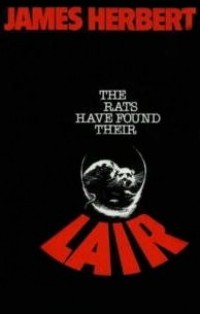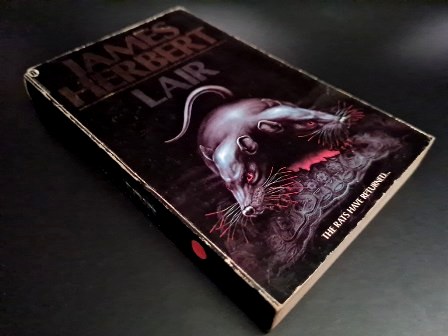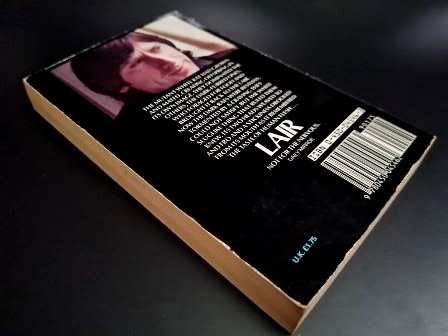
First published back in 1979, British horror author James Herbert’s hugely anticipated sequel to his classic debut novel ‘The Rats’ (1974) was entitled ‘Lair’ and followed the same no-holds-barred approach to graphic depictions of bloodshed and gore - later to be dubbed as the ‘splatterpunk’ subgenre.
DLS Synopsis:
After the hordes of giant black rats were eradicated from the evacuated streets on London by the combined use of ultrasonic sound beams and gas, the citizens of London once again returned to their dwellings in and around the city. However, there remained a single surviving rat who had been unable to follow the ultrasonic lure, and as such, remained trapped within the confines of a grocery store cellar. The rat soon gave birth to a litter, one of which was to become a new ‘mother rat’.
The cellar contained a wealth of food for the rats to consume until they were strong and fit adults. Upon the return of the shop’s owners, the rats are unwittingly released from the confines of the cellar after killing their unknowing captors. These remaining rats quickly vacate the London area, instead taking to the railway tunnels to emerge at the outskirts of Epping Forest. Now in this new environment away from mankind, the mutant rats can once again build up their numbers, slowly adapting and evolving to their new surroundings.
Four years pass without the rats presence being detected. With the increase in numbers, the local wildlife is soon falling prey to these vicious rodents. The rats move on to the easy pickings of the recently deceased that are buried within the local graveyard. With a food source now becoming scarcer, the giant rats look towards their enemies – mankind. Picking off the more isolated communities, such as the residents at a mobile home site, the rats begin their savage attacks on the humans once again.
Knowing the rats would not fall for the same ploy of using the ultrasonic equipment, the government have a new idea of how to eradicate the mutant rats once and for all. The rats have taken to burrowing tunnels within the woodland of Epping Forest. With the help of the Surrey based exterminators - Ratkill Laboratories (predominantly through the Ratkill employee Lucas Pender), together with the armed forces, their new plan is to pump cyanide gas down into the depths of these burrows whilst the rats remain submerged in their underground lair. However, it soon becomes apparent that the rats’ real lair is not amongst those gassed. Not only that, but an unrest between the black and the white rats is beginning to transpire. Mankind needs to work fast to find the rats true lair and kill off all of its inhabitants before the threat becomes too great…
DLS Review:
It was never going to be an easy task to follow on from the monumental release of the classic horror novel ‘The Rats’ (1974) which single-handily set in motion the wheels of the splatterpunk subgenre. The outrageous use of violence and bloodshed needed to be at the very least equally matched in order to allow the novel to steer clear of an out-and-out disappointment from this new breed of horror fans. With ‘Lair’ Herbert tackles this base requirement head-on, with a novel that simply bombards the reader with a veritable abundance of gore from the very outset.
The principal character of Harris from the earlier novel ‘The Rats’ has surprisingly been discarded in favour of the new principal protagonist - Lucas Pender. Herbert skirts over much of the novel’s the characterisation, even with this principal character, instead opting for a more plot driven storyline. That said, Pender does develop a love interest during the tale, but this is only given a very minor and loose importance to the storyline.
Although the plot is even more over-the-top than the first instalment in Herbert’s ‘Rats’ trilogy, ‘Lair’ still delivers a heart-racing storyline that works with a constantly building tension, as this returning epidemic becomes an even deadlier threat.
Herbert plays with the rats social hierarchy more within this sequel, clearly differentiating the roles of the colony into ‘workers’, ‘soldiers’ and the monstrously deformed ‘mother rats’. Comparable to that of hive based insects (such as ants etc), these different roles are even more clearly defined within this sequel, with the difference in fur colour depicting their role with ease. Like with Gregory A Douglas’ novel ‘The Nest’ (1980), the use of these different roles within the enemy further escalates the threat to new and more deadly heights, with an intelligence and organisation behind the rat colony making the rats a far foreboding foe.
The novel climaxes with a dramatic and breath-taking finale that sees all of the events spiralling to one suspenseful ending. Herbert keeps his foot on the accelerator until the very end, delivering a storyline that hurtles towards the final curtain without a moment’s pause.
For all-out-splatter-fun involving Herbert’s classic mutant rats, ‘Lair’ delivers this in abundance. The storyline does suffer somewhat from a lack of involved and interwoven subplots that would have ultimately had a more involved bearing on the final outcome. This seemingly one-dimensional storyline still offers up a fast paced roller-coaster of a ride, but fails to truly submerge the reader into any get depth to the unfolding plot.
The book runs for a total of 244 pages and was later followed up with the novel ‘Domain’ (1984) and even later with a graphic novel entitled ‘The City’ (1994).
© DLS Reviews
Other ‘Rats’ instalments:









